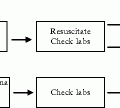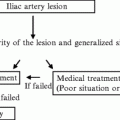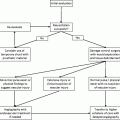Arterial
Intravascular foreign bodies
Unstable atherosclerotic plaques
Malignancies, especially mucin-producing adenocarcinomas
Antibody-mediated hypercoagulable states (Lupus, antiphospholipid syndrome)
Myeloproliferative syndromes (Polycythemia Vera and Essential Thrombocytosis)
Berger’s syndrome
Kawasaki’s syndrome
Aneurysms
Venous
Intravascular foreign bodies
Compression syndromes (May-Thurner, Paget-Schroetter, etc.)
Oral contraceptives
Malignancies, especially mucin producing adenocarcinomas
Genetic disorders (Factor V Leiden mutation, antithrombin III mutation, protein C deficiency, protein S deficiency, etc)
Antibody-mediated hypercoagulable states (Lupus, antiphospholipid syndrome)
Myeloproliferative syndromes (Polycythemia Vera and Essential Thrombocytosis)
Trauma and surgery
Prolonged immobility
Advanced age
Varicose veins
Arterial and venous
Intravascular foreign bodies
Malignancies, especially mucin producing adenocarcinomas
Antibody-mediated hypercoagulable states (Lupus, antiphospholipid syndrome)
Myeloproliferative syndromes (Polycythemia Vera and Essential Thrombocytosis)
Advanced age
A.
Cancer: Mucin-producing adenocarcinoma (lung cancer, colorectal cancer, and ovarian cancer especially) is a higher risk for venous thromboembolic events (VTE).
B.
Age: Statistically alone, age confers a thrombophilic state because most risk factors for thrombophilia (atherosclerosis, surgery, paralysis, cancer etc.) are commonly associated with older populations. Patients >50 years also has high antiphospholipid antibody counts of unknown significance. Animal models have also demonstrated age that may lead to higher concentrations of P-selectin and less inflammatory cells involved in fibrinolysis which may also contribute to age-related thrombophilia2.
C.
Heparin induced thrombocytopenia (HIT): HIT usually occurs 5–14 days after being exposed to heparin and is defined as a 50% drop in platelets associated with a recent exposure to any heparin. Typically it presents as a thrombotic, rather than a hemorrhagic, syndrome due to either a platelet-heparin complex which is benign and short lived (HIT Type I) or an antibody-mediated thrombocytopenia due to IgG versus heparin-platelet factor IV complex (HIT Type II). Antibody formation in patients undergoing cardiac surgery may occur in 25–50% of patients, but only 1–5% may develop HIT. This syndrome is estimated to occur in 50,000–250,000 cases a year in the United States. Depending on its manifestations, as many as 30% may die, 20% may require amputation and up to 50% may present with vascular occlusion4, 5.
Both hemorrhagic and thrombotic manifestations occur when platelets are <20,000/cc. Antibody complexes and platelet activation may result in DVT, renal failure, peripheral embolization, and even stroke. Empiric treatment and heparin avoidance must immediately follow any suspected case. Antigenic and functional confirmatory tests (HIT antibody ELISA and serotonin release assay respectively) should be done upon suspicion. The HIT ELISA detects antibodies in the patient’s blood, and the serotonin release assay detects abnormal activation of the patient’s platelets upon exposure to heparin. The syndrome is initially treated with nonheparin anticoagulants to limit hypercoagulable complications. According to the eighth ACCP guidelines, the following should be used as a continuous infusion with their associated grades of recommendations: Danaparoid [Grade 1B], lepirudin [Grade 1C], argatroban [Grade 1C], fondaparinux [Grade 2C], or bivalirudin [Grade 2C].6 The authors use Argatroban (if liver function is normal) or a hirudin inhibitor such as Lepirudin or Bivalirudin (if renal function is normal). They are titrated to a PTT 1.5–2 times normal. When platelet counts are >150,000/cc then oral vitamin K antagonists (VKAs) may be commenced for 6–8 weeks without stopping the intravenous anticoagulation until the goal INR is reached and then continued for five days after this (ACCP Guidelines Grade 1B). Because of several case reports of fondaparinux having cross-reactivity in cases of HIT, the authors do not use it for treatment of HIT.
Argatroban will falsely elevate the INR, and in order to determine if patients are therapeutic, if the INR is reported to be greater than 4, it may be necessary to stop the infusion for 4 h to determine the true INR while on VKA. Patients with type II HIT should avoid heparin thereafter and only be anticoagulated with thrombin inhibitors in the future.
D.
Essential Thrombocytosis (ET) and polycythemia vera (PV):
Essential thrombocytosis and polycythemia vera are chronic Philadelphia-negative myeloproliferative disorders that are associated with a high risk of arterial and venous thrombosis of both the small and the large vessels. The incidence of thrombotic events is unknown but may be as high as 50% upon diagnosis of either disease, but likely closer to 15–20%. Arterial thrombosis is more common in older patients with PV, and venous clots are more prevalent in those with ET and high hemoglobin concentrations, particularly if either have a history of a previous thrombotic event. The presence of leukocytosis at diagnosis has been suggested to play a role or predict the risk of clot formation, but its association has been questioned by recent studies7. There is also a higher risk of arterial thrombosis in patients with ET that have a JAK2V617F mutation. Cytoreduction is the key to lowering thrombotic risk in these patients, and low-dose aspirin may also be useful, but the Cochrane group’s meta-analysis of aspirin use shows no statistically significant benefit in patients with PV and there are no randomized trials available in ET.
E.
Pregnancy: Pregnancy and oral contraceptives are known risk factors for developing thromboembolic events. The overall incidence of venous thromboembolic event (VTE) during pregnancy is about 1/1,000 deliveries. It may be due to an increase in the amount of heparin-binding proteins, factor VIII, and fibrinogen in the setting of acquired activated protein C resistance.
Pregnancy may also unmask other inherited or antibody-mediated procoagulant disorders such as factor V Leiden, Protein C deficiency or antiphospholipid syndrome.
F.
HIV—AIDS: HIV has an increased risk of spontaneous thrombosis. It affects about 0.26–7% of HIV + patients and has become an emerging issue not previously noted. It may manifest as venous thromboembolic complications (>60%) or even acute myocardial infarction. There have been reports of increased anticardiolipin (antiphospholipid) antibodies as well as decreased protein S (anticoagulant) which may account for this. Epidemiological studies have implicated protease inhibitor antiretrovirals. Patients with AIDS are also prone to develop malignancies which may also contribute to the increased risk of thrombosis.
G.
Sepsis:
Infectious systemic inflammatory response syndrome is nearly always associated with some sort of hypercoagulable state. Clinically significant abnormalities occur in half to three quarters of patients with severe infections, and up to 35% will have DIC criteria. The etiology seems to be associated with an elevation of acute-phase reactants such as fibrinogen, C5a, and other compliment levels. Additionally, it is suspected that sepsis may uncover otherwise clinically dormant, inherited hypercoagulable conditions such as factor V Leiden as well as Protein C and S deficiencies with a decreased survival. This has led to a large amount of research and even consensus statements that advocate modulating the anticoagulant pathway using infusions of activated protein C as a way to improve survival in septic shock8.
H.
Noninherited thrombosis:
May-Thurner Syndrome
Iliac vein compression syndrome (May-Thurner syndrome) is venous outflow obstruction or thrombosis of the lower extremities due to venous compression by the overlying right iliac artery. It is more common in females and on their left iliac vein. Rarely it affects the right iliac vein and vena cava in patients with a high iliac artery bifurcation or left-sided IVC.
Ilio-femoral thrombosis per-se was traditionally treated with anticoagulation alone. However, it may be better treated with catheter-directed lysis/thrombectomy, and in May-Thurner syndrome, a closed-cell stent is placed in the compressed vein to diminish postthrombotic syndrome and maintain patency3.
The randomized, multicenter Acute Venous Thrombosis: Thrombus Removal With Adjunctive Catheter-Directed Thrombolysis (ATTRACT) trial (ClinicalTrials.gov identifier: NCT00790335) is planned to evaluate the outcomes of anticoagulation alone versus the use of pharmacomechanical thrombus removal in iliofemoral DVT.
If the thrombus extends below the inguinal ligament, then open thrombectomy and an arteriovenous fistula may be required. All cases of thrombosis are followed by anticoagulation with VKA and a follow-up venogram if stenting was performed.
Paget-Schrotter Syndrome (Stress Thrombosis)
Stay updated, free articles. Join our Telegram channel

Full access? Get Clinical Tree







